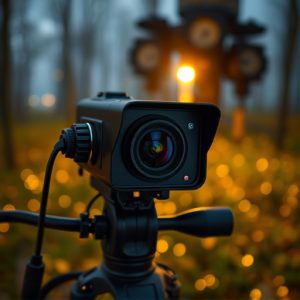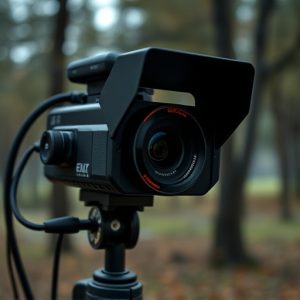Uncover Hidden Cameras: Detecting Tiny Monitoring Device Signals
Tiny cameras for home monitoring offer advanced privacy and security with high-resolution video, wir…….
Tiny cameras for home monitoring offer advanced privacy and security with high-resolution video, wireless transmission, and night vision. Detecting these devices requires systematic inspections, specialized equipment like RF detectors and infrared cameras, and scrutiny of power sources and network activity. Staying informed about technology advancements and legal/ethical considerations is crucial to safeguarding personal spaces from unwanted surveillance.
Hidden monitoring devices have become increasingly sophisticated, with tiny cameras offering unobtrusive home surveillance. Understanding these miniscule yet powerful tools is essential for maintaining privacy in today’s digital era. This article delves into the art of detecting hidden signals from these devices, covering everything from recognizing camera technology to advanced techniques and legal considerations. Learn how to navigate this complex landscape while ensuring your privacy remains intact.
- Understanding Tiny Camera Technology for Home Monitoring
- Locating and Detecting Hidden Monitoring Device Signals
- Advanced Techniques to Uncover Discreet Cameras
- Legal Considerations and Ethical Use of Hidden Monitoring Devices
Understanding Tiny Camera Technology for Home Monitoring
Tiny cameras for home monitoring have revolutionized privacy and security. These miniature devices pack advanced technology into compact forms, allowing them to capture high-resolution video and transmit it wirelessly to your smartphone or computer. Understanding their capabilities is crucial when setting up an effective home monitoring system.
One key aspect to consider with tiny cameras is their size and placement. Due to their small stature, they can be discreetly positioned in various spots around your home, from corners of rooms to strategic points outside. This versatility enables continuous observation without raising suspicion. Moreover, these cameras often come equipped with night vision capabilities, ensuring round-the-clock monitoring.
Locating and Detecting Hidden Monitoring Device Signals
Locating and Detecting Hidden Monitoring Device Signals
When it comes to hidden monitoring devices, such as tiny cameras for home monitoring, the key is to approach the search methodically. Start by thoroughly inspecting every nook and cranny of the area you suspect might be under surveillance. Look for any unusual objects or setups that could indicate the presence of a hidden camera, like small holes where cables have been drilled or mounted devices in obscure locations. Using specialized equipment like RF detectors and infrared cameras can significantly aid in this process, as these tools are designed to uncover hidden signals and visual sources.
Additionally, be mindful of power sources and any irregular electrical installations. Monitoring devices often require a consistent power supply, so checking for unusual wiring or hidden batteries can provide valuable clues. In today’s digital age, even subtle signs like unusual network activity on your home’s router could indicate the operation of a hidden monitoring device. Staying vigilant and employing these detection techniques will go a long way in ensuring your privacy.
Advanced Techniques to Uncover Discreet Cameras
In the realm of home monitoring, tiny cameras have become a subtle yet powerful tool. Advanced techniques are now available to uncover these discreet devices, ensuring your privacy and security. One effective method involves utilizing specialized equipment that can detect electromagnetic emissions, as many hidden cameras emit faint signals. This approach requires a keen eye for detail and access to the latest technology.
Additionally, thorough inspections of potential hiding spots are crucial. Examining wall cracks, ceiling joints, and even door frames can reveal tiny cameras that might be hidden within. It’s also beneficial to stay updated on the latest types of hidden surveillance equipment, as manufacturers continually innovate new, more compact designs. This knowledge enables you to anticipate and identify these devices effectively.
Legal Considerations and Ethical Use of Hidden Monitoring Devices
When using hidden monitoring devices, such as tiny cameras for home monitoring, it’s crucial to be aware of legal considerations and ethical boundaries. The use of surveillance technology raises important privacy concerns, and its deployment must adhere to local laws and regulations. In many jurisdictions, there are strict rules regarding consent, reasonable expectation of privacy, and the type of information that can be legally collected and monitored.
Using hidden cameras for security purposes may infringe on an individual’s right to privacy if not implemented correctly. It is essential to obtain proper authorization or ensure a legitimate need for monitoring exists, such as in cases of domestic violence or property security. Ethical use demands transparency about the presence of these devices and clear communication regarding data storage and access to ensure that personal information remains secure and confidential.
In today’s digital age, understanding and detecting hidden monitoring device signals is crucial for maintaining privacy. This article has explored various techniques, from tiny camera technology to advanced signal detection methods, empowering folks to navigate the intricate landscape of home monitoring. By remaining vigilant and adopting proactive measures, individuals can safeguard their personal spaces in a bustling world where discretely placed cameras are becoming increasingly sophisticated. Remember that knowledge is power; staying informed about these tools helps foster a sense of security and control over one’s environment, ensuring peace of mind.


